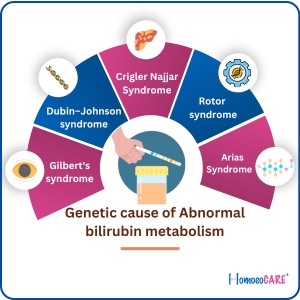Copyright © 2025 Homoeocare. All Rights Reserved.
Powered By
When facing genetic conditions like Crigler-Najjar syndrome, families can find hope through innovative treatments, including homeopathy. Homeopathic approaches to Crigler-Najjar syndrome offer a supportive path that reduces the impact of gene mutations and promotes an improved quality of life.
Crigler-Najjar syndrome (CNS) is a rare genetic disorder resulting from a mutation in the UGT1A1 gene, which affects the body’s ability to process bilirubin, a yellow pigment produced by the breakdown of red blood cells. This autosomal recessive condition, often associated with consanguineous marriages, leads to a dangerous buildup of unconjugated bilirubin, especially impacting infants’ brain development.
Bilirubin, a yellow pigment formed from the breakdown of red blood cells, usually undergoes processing in the liver, where unconjugated (indirect) bilirubin is converted into conjugated (water-soluble) bilirubin for easy excretion. In Crigler-Najjar syndrome, the lack of proper bilirubin metabolism causes a dangerous increase in unconjugated bilirubin, potentially leading to serious neurological damage if untreated.
The hallmark symptom of Crigler-Najjar syndrome is persistent jaundice, with yellowing of the skin and eyes. Severe cases may also present symptoms affecting the brain, including:
Crigler-Najjar syndrome is divided into two types:
There are 5 types of genetic diseases related to problems in Bilirubin Metabolism.

Crigler-Najjar syndrome follows an autosomal recessive genetic pattern, meaning a child must inherit two mutated genes—one from each parent—to develop the condition. Parents who carry a single copy of the mutation are typically asymptomatic carriers.
The following tests are typically used to diagnose Crigler-Najjar syndrome:
At HomoeoCARE, a specialized approach based on Dr. Pravin Jain’s research addresses genetic disorders like Crigler-Najjar syndrome. This process begins with analyzing genetic reports from the child and parents. In cases where no parental mutation is detected, the focus shifts to maternal history during pregnancy, helping identify any environmental or stress factors potentially influencing gene mutation.
When both parents test positive for the gene mutation, a comprehensive case history of both parents and child is used to tailor an individualized homeopathic plan. By carefully addressing genetic factors, HomoeoCARE’s holistic approach has shown promise in reducing the impact of Crigler-Najjar syndrome on the brain and aiding in developmental recovery.
A male infant diagnosed with Crigler-Najjar syndrome began homeopathic treatment at HomoeoCARE after conventional therapies proved ineffective. The child’s bilirubin levels, initially at a dangerous 26, dropped to 17 within two weeks of starting treatment, further improving to 7.01, and then 4.8. Within six months, his bilirubin levels were stable, and he continued to reach age-appropriate developmental milestones. Today, he engages in typical activities for his age, highlighting the transformative potential of homeopathy for genetic disorders like Crigler-Najjar syndrome.
Crigler-Najjar syndrome can be challenging, but with HomoeoCARE’s individualized homeopathic strategies, patients can experience improved health and development. Reach out to HomoeoCARE to explore how homeopathy can make a meaningful difference in the management of Crigler-Najjar syndrome.
HomoeoCARE, we’ve built a reputation as one of the top homeopathic clinics in Mumbai, offering solutions where traditional medicine hasn’t been able to help. Experience the healing power of homeopathy through our online homeopathy consultation with experienced online homeopathy doctors. But don’t just take our word for it check out our case studies to see how we’ve positively impacted the lives of so many individuals and families with our unique approach to healthcare.
Copyright © 2025 Homoeocare. All Rights Reserved.
Powered By